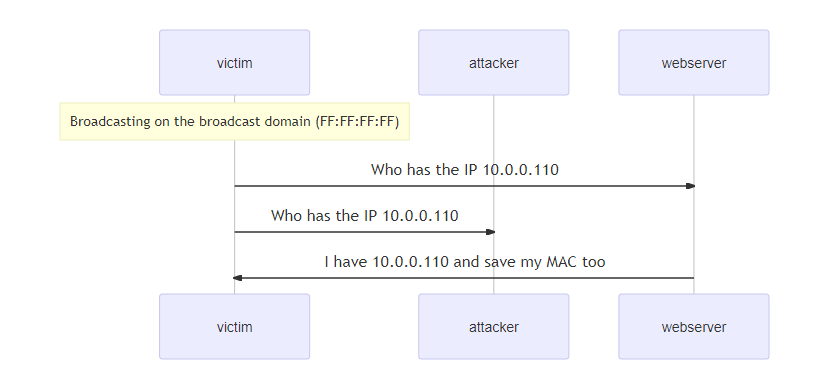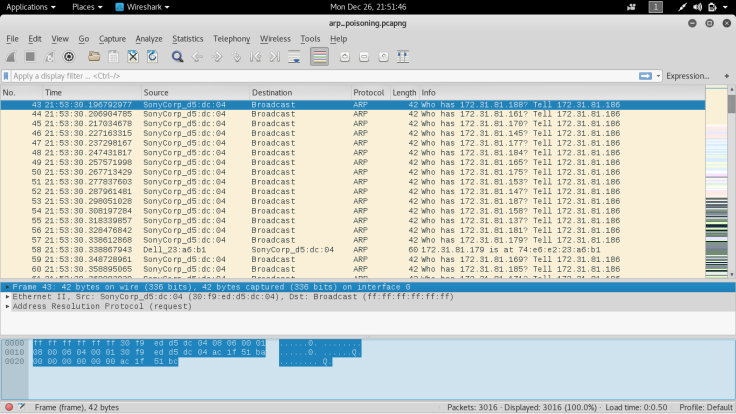

- Arpspoof, part of the ettercap suite, can be used to spoof arp table update#
- Arpspoof, part of the ettercap suite, can be used to spoof arp table software#
- Arpspoof, part of the ettercap suite, can be used to spoof arp table mac#
Arpspoof, part of the ettercap suite, can be used to spoof arp table update#
Linux ignores unsolicited replies, but on the other hand uses seen requests from other machines to update its cache. Operating systems react differently, e.g. In a more passive approach a device listens for ARP replies on a network, and sends a notification via email when an ARP entry changes.
Arpspoof, part of the ettercap suite, can be used to spoof arp table mac#
The existence of multiple IP addresses associated with a single MAC address may indicate an ARP spoof attack, although there are legitimate uses of such a configuration. This capability may be implemented in individual hosts or may be integrated into Ethernet switches or other network equipment. These techniques may be integrated with the DHCP server so that both dynamic and static IP addresses are certified. Uncertified ARP responses are then blocked.
Arpspoof, part of the ettercap suite, can be used to spoof arp table software#
Software that detects ARP spoofing generally relies on some form of certification or cross-checking of ARP responses. While static entries provide some security against spoofing if the operating system handles them correctly, they result in maintenance efforts as address mappings of all systems in the network have to be distributed.

IP address-to-MAC address mappings in the local ARP cache may be statically entered so that hosts ignore all ARP reply packets. The attacker may choose to inspect the packets (spying), while forwarding the traffic to the actual default gateway to avoid discovery, modify the data before forwarding it (man-in-the-middle attack), or launch a denial-of-service attack by causing some or all of the packets on the network to be dropped.

Generally, the goal of the attack is to associate the attacker's host MAC address with the IP address of a target host, so that any traffic meant for the target host will be sent to the attacker's host. ARP spoofing attacks can be run from a compromised host on the LAN, or from an attacker's machine that is connected directly to the target LAN. The basic principle behind ARP spoofing is to exploit the above-mentioned vulnerabilities in the ARP protocol by sending spoofed ARP messages onto the LAN. This behavior is the vulnerability which allows ARP spoofing to occur.

There is no method in the ARP protocol by which a host can authenticate the peer from which the packet originated. Even ARP entries which have not yet expired will be overwritten when a new ARP reply packet is received. Network hosts will automatically cache any ARP replies they receive, regardless of whether Network hosts requested them. The destination machine with the IP in the ARP request then responds with an ARP reply, which contains the MAC address for that IP.ĪRP is a stateless protocol. When another host's IP address is known, and its MAC address is needed, a broadcast packet is sent out on the local network. When an Internet Protocol (IP) datagram is sent from one host to another in a local area network, the destination IP address must be resolved to a MAC address for transmission via the data link layer. The Address Resolution Protocol is a widely used communications protocol for resolving Internet layer addresses into link layer addresses. The attack can only be used on networks that use the Address Resolution Protocol, and is limited to local network segments. Often the attack is used as an opening for other attacks, such as denial of service, man in the middle, or session hijacking attacks. Generally, the aim is to associate the attacker's MAC address with the IP address of another host, such as the default gateway, causing any traffic meant for that IP address to be sent to the attacker instead.ĪRP spoofing may allow an attacker to intercept data frames on a network, modify the traffic, or stop all traffic. In computer networking, ARP spoofing, ARP cache poisoning, or ARP poison routing, is a technique by which an attacker sends (spoofed) Address Resolution Protocol (ARP) messages onto a local area network.


 0 kommentar(er)
0 kommentar(er)
